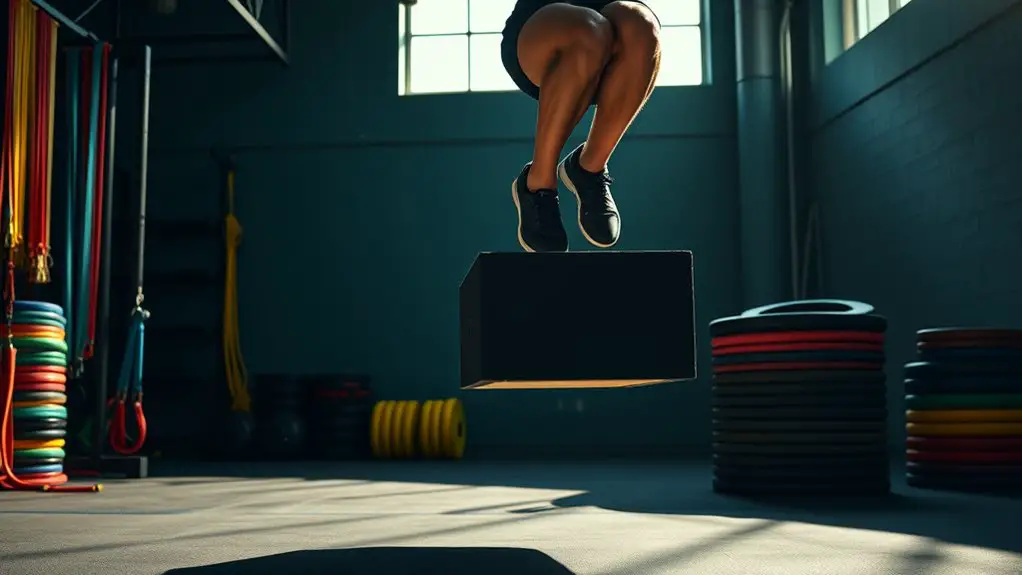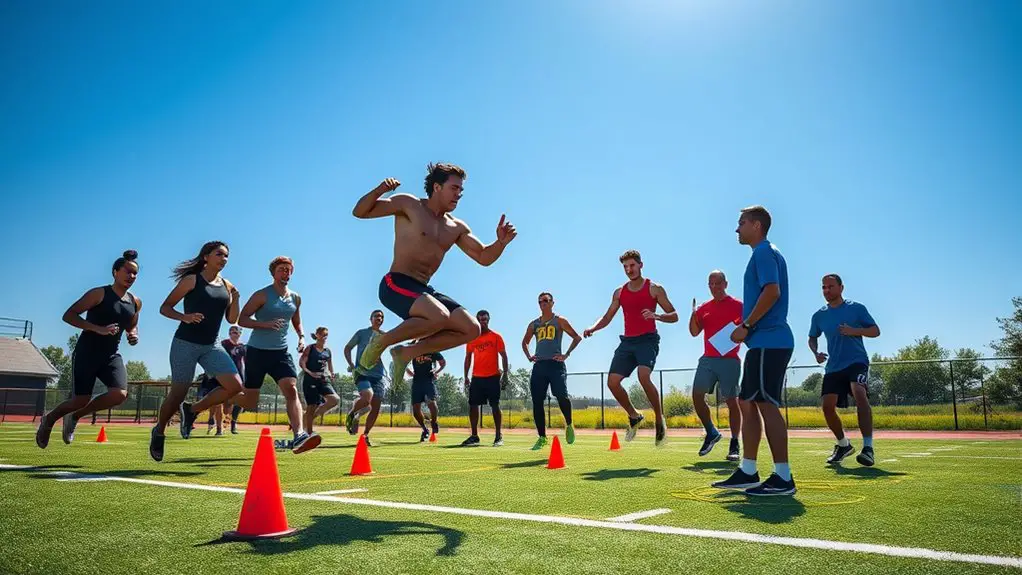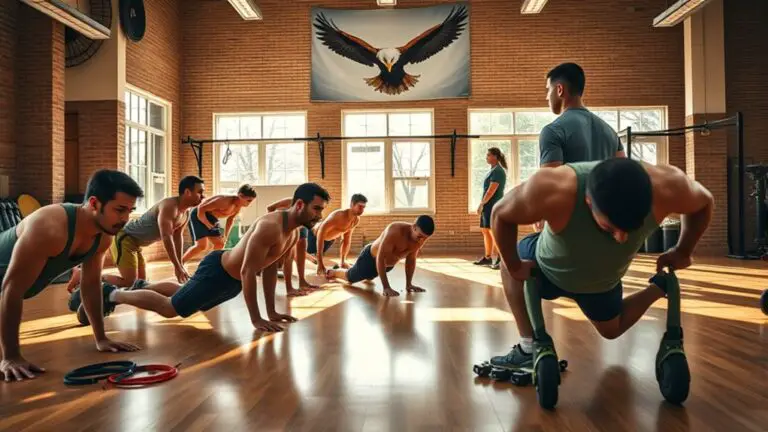The Best Jump Training Workouts for Athletic Performance

Jump training workouts are essential for enhancing your athletic performance. Focus on plyometric drills like box jumps and tuck jumps to improve your vertical leap, while incorporating strength exercises like squats and deadlifts for explosive power. Agility training is vital too; ladder drills and cone sprints will elevate your footwork. Design a balanced program with a mix of these elements, and you’ll see significant improvement in your speed and coordination. Discover even more effective strategies to take your training to the next level!
Understanding the Benefits of Jump Training

When you immerse yourself in jump training, you’re not just adding variety to your workouts; you’re revealing a host of benefits that can elevate your athletic performance and overall fitness. By focusing on jump mechanics, you’ll improve your explosive power, which is vital for any sport. As you hone these mechanics, you’ll also enhance your body’s ability to generate force quickly, making you faster and more agile.
Jump training markedly contributes to athletic conditioning, targeting both strength and cardiovascular fitness. It builds muscle in your legs and core, while also increasing your endurance. Plus, the dynamic nature of jumps helps improve coordination and balance, essential skills for any athlete. As you progress, you’ll notice not only physical improvements but also a boost in your confidence and motivation. Embrace jump training, and watch it transform your performance on and off the field. Additionally, incorporating skipping rope into your routine can help to increase your vertical jump height, making your training even more effective.
Essential Plyometric Drills for Vertical Leap
To enhance your vertical leap, incorporating essential plyometric drills into your training routine is key. These drills focus on explosive movements that improve your jump mechanics and overall athletic performance. Start with box jumps, where you leap onto a sturdy platform, landing softly to promote proper technique. Follow up with depth jumps, which train your reactive strength by jumping off a box and immediately rebounding upwards upon landing.
Another effective drill is the tuck jump, where you explode upwards while bringing your knees to your chest, enhancing your power and coordination. Don’t forget lateral bounds, as they improve your agility and balance, essential for overall jumping ability. Incorporating various exercises can prevent workout monotony and enhance overall fitness levels. Try integrating these plyometric variations into your workouts, ensuring you give your muscles adequate recovery time. Consistent practice will not only elevate your vertical leap but also boost your confidence on the court or field. Keep pushing your limits!
Strength Exercises to Boost Explosiveness

Release your potential by incorporating strength exercises designed to boost explosiveness into your training regimen. Building explosive power through strength conditioning is essential for enhancing your athletic performance. Focus on compound movements that engage multiple muscle groups, allowing you to develop the strength needed for explosive jumps. Additionally, integrating exercises like skipping rope can further improve your cardiovascular endurance, which is crucial for sustained athletic performance.
Here’s a quick reference table for effective strength exercises:
| Exercise | Benefits |
|---|---|
| Squats | Builds leg strength & power |
| Deadlifts | Enhances posterior chain power |
| Bench Press | Strengthens upper body explosiveness |
| Power Cleans | Develops full-body explosiveness |
| Box Jumps | Improves reactive strength |
Incorporate these exercises to elevate your training. As you build strength, you’ll find that your ability to launch into the air improves, helping you achieve your athletic goals. Remember, consistency is key!
Incorporating Agility Training Into Your Routine
Strength exercises lay a solid foundation for explosive power, but agility training takes your performance to the next level by enhancing your quickness and coordination. To incorporate agility training into your routine, start with agility drills that challenge your body to react quickly. Ladder drills, cone sprints, and shuttle runs are excellent ways to improve your footwork and overall athleticism.
Focus on mastering footwork exercises, as they build the necessary skills to change direction swiftly and maintain balance. Incorporate these drills at least twice a week, mixing them with your jump training workouts for ideal results.
As you progress, increase the intensity and complexity of your drills to guarantee continuous improvement. Remember, agility isn’t just about speed; it’s about precision and control. By dedicating time to agility training, you’ll enhance your performance on the court or field, giving you the edge over your competition.
Designing a Jump Training Program for Your Needs

When you’re ready to elevate your jumping ability, designing a tailored jump training program is vital for maximizing your potential. Start by evaluating your individual goals—whether you want to increase vertical leap, improve explosiveness, or enhance overall athletic performance. Your program should reflect these objectives and prioritize exercises that align with them.
Next, consider your training frequency. A balanced approach typically involves three to four sessions per week, allowing for recovery while maintaining intensity. Each session should include a mix of plyometric exercises, strength training, and mobility work to guarantee thorough development, and incorporating jump rope can enhance your cardiovascular fitness and coordination.
Remember to track your progress and adjust your program as needed. This not only keeps you motivated but also confirms you’re continuously challenging yourself. By aligning your training with your specific goals and maintaining a consistent frequency, you’ll be on the path to achieving impressive jumping heights and overall athletic excellence.
Frequently Asked Questions
How Often Should I Do Jump Training Each Week?
When considering how often you should do jump training each week, frequency recommendations typically suggest two to three sessions. This allows your body to recover while still reaping the jump training benefits, like improved power, agility, and explosiveness. It’s essential to listen to your body; if you’re feeling fatigued, don’t hesitate to adjust your schedule. Consistency is key, but quality training sessions will yield the best results in your athletic performance.
Can Jump Training Help With Injury Prevention?
Absolutely, jump training can be a game-changer for injury prevention! By focusing on proper jump mechanics, you’re not just enhancing your performance but also strengthening the muscles and joints essential for stability. It helps improve your body’s ability to handle impact, reducing the risk of injuries. When you train consistently, you’re building resilience and ensuring that your movements are efficient and safe. So, get started and protect yourself while boosting your athletic skills!
What Equipment Do I Need for Jump Training?
For effective jump training, you don’t need much equipment. A good jump rope can enhance your agility and coordination, making it a staple in your routine. Resistance bands are also invaluable; they add resistance to your workouts, helping to build strength and power in your legs. With just these two tools, you can create a versatile training program that’ll elevate your jumping ability and boost your athletic performance. Get started today!
At What Age Can Kids Start Jump Training?
You might wonder if there’s a magic age for kids to start jump training. Generally, children can begin around age 6, as they’re hitting key developmental milestones. However, safety considerations are critical; guarantee they have proper supervision and technique training. Focus on fun, engaging activities to build their confidence. With the right approach, you’ll help them develop not just jumping skills, but also a love for physical activity that lasts a lifetime!
How Long Will It Take to See Results?
You’re likely wondering about the results timeline for your jump training. While some may see improvements in just a few weeks, others might take a couple of months. Individual factors, like your current fitness level, consistency, and training intensity, play a significant role in how quickly you’ll notice changes. Stay committed, and remember that progress varies—trust the process, and you’ll reach your goals faster than you think!





